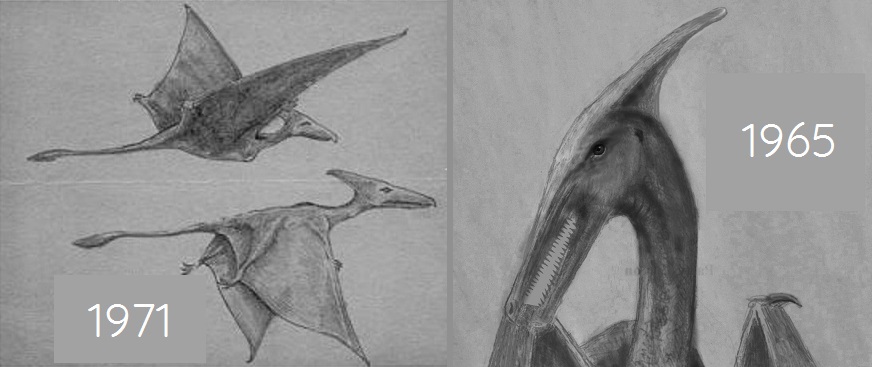By the investigative journalist Jonathan Whitcomb
I’m writing a nonfiction book for children, which should be in print in November of 2018: The Girl who saw a Flying Dinosaur. [Addendum: This cryptozoology book was published on Nov 8th] It covers far more than just the true story of Patty Carson. It compares her sighting to the one by the US Marine Eskin Kuhn, who encountered two “pterodactyls” at that same area in Cuba but six years later.
Two Important Sightings at Guantanamo Bay
One critic might dismiss the report by Patty Carson, saying it was just the imagination of a small girl. But why would that US Marine see two flying creatures that were so similar to the one seen by that child? Keep in mind that both reports come from Guantanamo Bay, and the sightings were only six years apart.
A critic might dismiss the sketch by Patty Carson, saying it was drawn decades after the event. But look at the sketch by Eskin Kuhn: It was drawn within minutes of his sighting of two large pterosaurs that he originally called “pterodactyls.” Compare those two drawing and notice important similarities:
Drawn by Eskin Kuhn (left) and by Patty Carson (right)
A critic might dismiss Kuhn’s sighting as just a misidentification of two birds flying together. But be aware that Patty saw many small teeth in the beak of the flying creature she saw. Birds do not have teeth.
A critic might dismiss the US Marines sighting, for those two things were flying by him, leaving him limited opportunity to look closely. But Patty Carson was staring at that flying creature for some time, as it stood there for some time. She had ample opportunity to examine details in its appearance.
Why did Kuhn not report seeing any teeth in the two “pterodactyls” he saw? They were flying with their mouths shut. Why did Carson not report any hair on the tail flange of the flying creature she saw? Kuhn noticed that hair. The girl probably paid less attention to the end of the tail, or perhaps the tail was moving a bit too much to notice that detail. She did see the tail clearly enough to see that the tail end had a flange that she described as “diamond” shaped.
Why do not more people report seeing these living pterosaurs, if they exist? I, Jonathan Whitcomb, have received hundreds of eyewitness reports, over the past 15 years, reports from five continents. From examining those accounts and comparing them to each other, I have concluded the following: The total number of persons now living, worldwide, who have had some kind of encounter with a living pterosaur—those persons number at least in the range of between 7 million and 128 million, although we need to keep in mind that this estimate includes encounters that were brief and many were at night, when few, if any, details could have been seen.
Check out the book The Girl who saw a Flying Dinosaur, available soon on Amazon and other online retail book sellers. Give a copy as a gift to a child.
###
.
The Girl who saw a Flying Dinosaur
What a wonderful world we live in, a world filled with an astonishing variety of life! If all those varied forms known to Western science are not enough, we now have worldwide confirmations, from many eyewitnesses, that a long-tailed pterosaur species is still living among us . . .
.
How big are modern pterosaurs? Choose almost any wingspan; we’ve got it. Here are the eyewitness estimates for wingspan, in feet, from smallest to largest . . .
.
Although it’s more common, in the United States, for an eyewitness of an apparent living pterosaur to use the word pterodactyl, I sometimes come across the phrase “flying dinosaur.”
.
The girl who saw a modern pterosaur
[what a girl saw in Texas] . . . I was about 11-12 yrs old I went outside around late morning . . . In the open backyard next door was what looked like a 9 or 10 ft tall man . . . then the man turned and I realized that this man didn’t have a face like a man . . .
.
“Dinosaur birds” are still flying
We have been taught that giant flying creatures soared overhead long ago. We could call them “dinosaur birds,” but that would be technically incorrect: They were pterosaurs . . .
.
The true story of Patty Carson and others
Patty Carson, of Southern California, said, “It did have a tail and it had a diamond shaped tip . . . The skin was a leathery, brownish reddish color. It had little teeth, a LOT of them.
.
They are not extinct – “dinosaur birds”
Who could organize any expedition to search for living pterosaurs? Only an official discovery could awaken Western scientists so they could search for extant pterosaurs, but discovery normally comes after searching, not before. Looking back at this problem, from the time of Darwin until 1990 it appears to have been an almost hopeless atmosphere for a discovery. But a solution eventually appeared . . . from an unexpected source.



